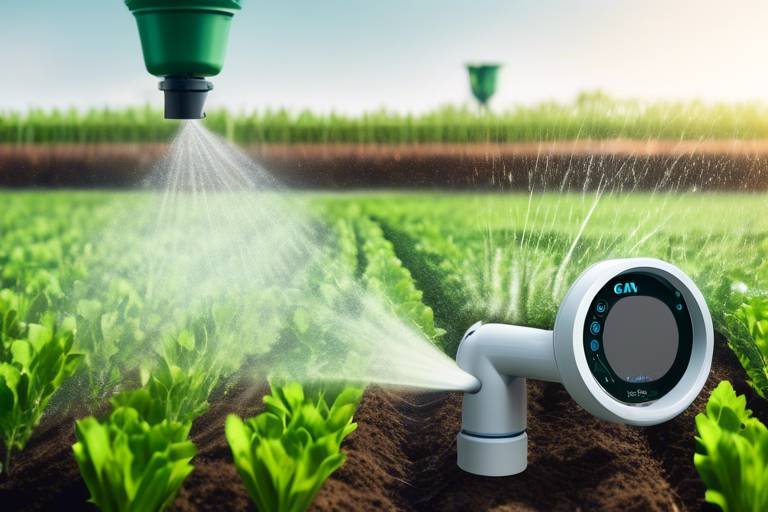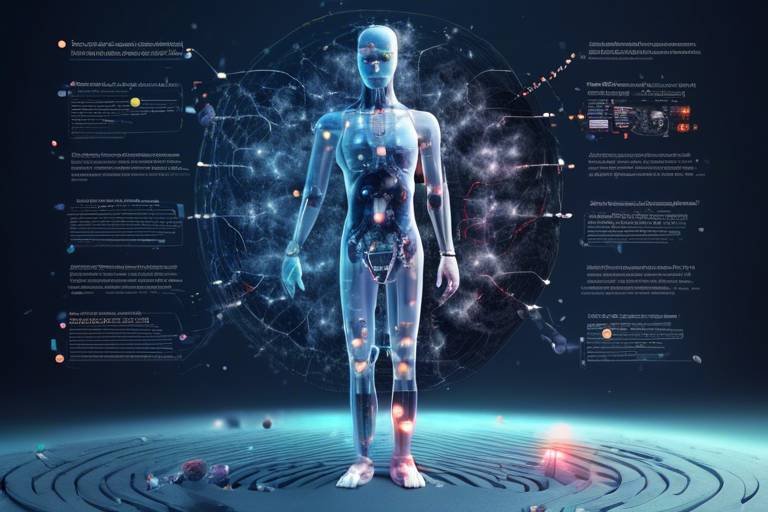Smart Irrigation Powered by AI
In today's rapidly evolving agricultural landscape, the integration of technology has become a game-changer. One of the most exciting advancements is smart irrigation powered by artificial intelligence (AI). Imagine a world where farmers no longer have to guess how much water their crops need. Instead, they can rely on sophisticated systems that analyze real-time data to make informed decisions. This transformative approach not only enhances efficiency but also addresses the pressing issue of water scarcity, a challenge that is becoming increasingly critical as global populations grow and climate change impacts weather patterns.
Smart irrigation systems utilize a combination of sensors, data analytics, and AI algorithms to optimize water usage. These systems ensure that crops receive the right amount of water at the right time, thereby promoting sustainable agricultural practices. But what does this really mean for farmers? It means less water waste, healthier crops, and ultimately, better yields. The implications are profound, as they contribute to a more sustainable future for agriculture, allowing farmers to do more with less.
At the heart of smart irrigation is the ability to make data-driven decisions. By harnessing the power of AI, these systems can analyze vast amounts of data, from soil moisture levels to weather forecasts, to determine the precise irrigation needs of crops. This level of precision is akin to having a personal assistant who knows exactly when to water your plants, taking the guesswork out of irrigation.
Moreover, the benefits extend beyond just water conservation. AI-powered irrigation can lead to significant cost savings for farmers. By reducing water usage and optimizing irrigation schedules, farmers can lower their operational costs. In essence, smart irrigation not only helps the environment but also boosts the bottom line for agricultural businesses.
As we dive deeper into the world of smart irrigation powered by AI, it’s essential to understand the technology behind these systems, the data collection techniques they employ, and the myriad of benefits they offer. The future of agriculture is here, and it’s smarter than ever!
- What is smart irrigation? Smart irrigation refers to advanced systems that use technology to optimize water usage in agriculture.
- How does AI improve irrigation? AI analyzes data from various sources to predict water needs and automate irrigation schedules, enhancing crop health and resource management.
- What data collection techniques are used? Common techniques include soil moisture sensors and weather forecasting integration to gather essential information for irrigation decisions.
- What are the benefits of AI-powered irrigation? Benefits include reduced water consumption, improved crop yields, and lower operational costs.
- What challenges does smart irrigation face? Challenges include high initial costs, the need for technical expertise, and potential data privacy concerns.

Understanding Smart Irrigation
Smart irrigation is a revolutionary approach that leverages cutting-edge technology to optimize water usage in agriculture. Imagine a system that not only waters your crops but does so intelligently, ensuring that each plant receives the precise amount of water it needs at any given time. This innovation is particularly vital in today's world, where water scarcity is becoming an increasingly pressing issue. By utilizing smart irrigation techniques, farmers can promote sustainable agricultural practices while enhancing crop health and productivity.
At its core, smart irrigation involves the integration of various technologies, such as sensors, weather data, and automated systems. These components work together to create a responsive irrigation system that adapts to the ever-changing environmental conditions. For instance, when the soil moisture sensors detect that the ground is adequately hydrated, the system can delay irrigation, conserving precious water resources. Conversely, during dry spells, it can automatically trigger watering, ensuring that crops remain healthy and productive.
Moreover, smart irrigation systems can be tailored to different types of crops and local conditions. This customization is crucial because not all plants have the same water requirements. For example, a tomato plant may need more frequent watering than a cactus. By understanding these specific needs, smart irrigation can be fine-tuned to maximize efficiency. The result? A significant reduction in water waste, which not only benefits the environment but also translates into cost savings for farmers.
To further illustrate the advantages of smart irrigation, let's consider some key features:
- Real-time Monitoring: Continuous data collection allows farmers to make informed decisions based on actual conditions rather than outdated schedules.
- Automated Scheduling: Irrigation can be scheduled based on predictive analytics, ensuring that crops are watered at optimal times.
- Resource Optimization: By using water more efficiently, farmers can reduce their operational costs while maintaining high crop yields.
In summary, understanding smart irrigation is crucial for anyone involved in agriculture today. By embracing these advanced systems, farmers can not only enhance their productivity but also contribute to a more sustainable future. As we delve deeper into the role of artificial intelligence in irrigation, we will uncover how these technologies are transforming the agricultural landscape.

The Role of AI in Irrigation
Artificial intelligence is revolutionizing the way we approach irrigation, transforming traditional practices into smart, data-driven processes. Imagine a world where farmers don’t just guess how much water their crops need, but instead have precise, real-time data guiding their decisions. This is the power of AI in irrigation. By analyzing vast amounts of data from various sources, AI systems can predict the water needs of different crops, ensuring that each plant receives just the right amount of moisture at the perfect time.
One of the most significant advancements in this area is the ability of AI to automate irrigation schedules. Instead of relying on a one-size-fits-all approach, AI can tailor watering schedules based on specific crop requirements and environmental conditions. For instance, if a weather forecast predicts rain, the AI can adjust the irrigation plan accordingly, conserving precious water resources and preventing overwatering. This not only helps in minimizing water waste but also enhances the overall health of the crops, leading to better yields.
AI-driven irrigation systems utilize a variety of data inputs, including:
- Soil moisture levels: Continuous monitoring ensures that the soil is neither too dry nor too saturated.
- Weather patterns: Real-time weather data helps in adjusting irrigation schedules based on upcoming rainfall or temperature fluctuations.
- Crop type and growth stage: Different crops have varying water needs; AI can adapt to these differences seamlessly.
Moreover, these systems can learn from historical data. By analyzing previous irrigation outcomes and crop performances, AI can refine its algorithms to improve future irrigation strategies. This aspect of machine learning means that the more these systems are used, the smarter they become. It's like having a personal assistant who always learns from past experiences to make better decisions in the future.
In addition to improving efficiency, AI in irrigation also plays a pivotal role in sustainability. As water scarcity becomes an increasingly pressing issue globally, the need for more efficient water use in agriculture cannot be overstated. By optimizing water application through AI technology, farmers can significantly reduce their water consumption, which not only benefits their bottom line but also contributes to environmental conservation efforts.
However, the integration of AI into irrigation systems is not without its challenges. Farmers must be equipped with the right tools and knowledge to harness this technology effectively. This is where training and support come into play. As the agricultural sector embraces these innovations, educational resources will be crucial in ensuring that all farmers, regardless of their technical background, can benefit from AI-driven irrigation solutions.
In conclusion, the role of AI in irrigation is multifaceted and transformative. By leveraging data and automation, AI not only enhances water efficiency but also supports sustainable agricultural practices. As we move forward, the potential for AI to reshape our approach to irrigation is vast, promising a future where agriculture can thrive even in the face of water scarcity challenges.
Q: How does AI determine the right amount of water for crops?
A: AI analyzes data from soil moisture sensors, weather forecasts, and historical irrigation patterns to determine the precise water needs of crops.
Q: Can AI irrigation systems work with existing irrigation infrastructure?
A: Yes, many AI solutions can be integrated with existing systems, enhancing their efficiency without the need for complete overhauls.
Q: What are the costs associated with implementing AI in irrigation?
A: While the initial investment can be significant, the long-term savings in water usage and improved crop yields often outweigh these costs.
Q: Is technical expertise required to operate AI irrigation systems?
A: Some level of technical knowledge is beneficial, but many systems are designed to be user-friendly, with training and support available for farmers.

Data Collection Techniques
In the realm of smart irrigation, effective data collection is the backbone that supports all decision-making processes. The integration of various technologies not only enhances the efficiency of water usage but also ensures that crops receive the precise amount of moisture they need to thrive. To achieve this, several data collection techniques are employed, each serving a unique purpose in the overall irrigation strategy.
One of the most prominent methods is the use of soil moisture sensors. These devices are strategically placed in the ground to measure the water content in the soil. By providing real-time data, farmers can make informed decisions about when and how much to irrigate. Imagine having a personal assistant who tells you exactly when to water your plants, based on their actual needs rather than a predetermined schedule. This not only conserves water but also promotes healthier crop growth.
Another essential technique is the integration of weather forecasting. By utilizing advanced weather models and satellite imagery, smart irrigation systems can predict rainfall and temperature fluctuations. This information is crucial because it allows farmers to adjust their irrigation schedules accordingly. For instance, if rain is forecasted, the system can delay watering, thereby conserving water resources. This dynamic approach to irrigation is akin to having a weather-savvy friend who helps you plan your gardening activities.
Moreover, the combination of these two techniques creates a powerful synergy that enhances the overall effectiveness of irrigation systems. Consider the following table that highlights the key features and benefits of these data collection techniques:
| Technique | Key Features | Benefits |
|---|---|---|
| Soil Moisture Sensors | Real-time monitoring, Precision irrigation | Water conservation, Improved crop health |
| Weather Forecasting | Predictive analytics, Climate adaptation | Reduced water usage, Enhanced resilience |
In conclusion, the combination of soil moisture sensors and weather forecasting creates a robust framework for smart irrigation. The data collected through these techniques empowers farmers to make better decisions, ultimately leading to more sustainable agricultural practices. As technology continues to evolve, we can expect even more innovative methods to emerge, further revolutionizing the way we approach irrigation.
- What is smart irrigation? Smart irrigation refers to advanced systems that utilize technology to optimize water usage for crops.
- How do soil moisture sensors work? Soil moisture sensors measure the water content in the soil, providing real-time data to improve irrigation decisions.
- What are the benefits of using AI in irrigation? AI-powered irrigation systems can reduce water consumption, improve crop yields, and lower operational costs.
- What challenges do farmers face when adopting smart irrigation? Initial investment costs and the need for technical expertise can be significant barriers for some farmers.

Soil Moisture Sensors
Soil moisture sensors are revolutionary tools that play a pivotal role in smart irrigation systems. They serve as the eyes and ears of farmers, providing real-time data on the water content in the soil. Imagine being able to *know exactly* when your plants are thirsty without having to guess or rely on outdated schedules! These sensors measure the volumetric water content in the soil, allowing for precise irrigation decisions tailored to the actual needs of the crops. This means that rather than watering on a fixed schedule, farmers can ensure their crops receive the optimal amount of water at the right time.
The technology behind soil moisture sensors has evolved significantly. Today, there are various types of sensors available, each with its own advantages. For instance, some sensors utilize tensiometers to measure the tension of water in the soil, while others employ capacitance methods, which gauge the dielectric constant of the soil. This variety allows farmers to choose the best option based on their specific agricultural needs and soil types.
In addition to providing immediate feedback on soil moisture levels, these sensors can be integrated with irrigation systems to automate watering schedules. This integration not only conserves water but also enhances crop health by preventing overwatering, which can lead to root rot and other issues. By utilizing soil moisture sensors, farmers can significantly reduce water waste, making their operations more sustainable and cost-effective. The data collected can also be analyzed over time to identify trends and make informed decisions regarding crop management.
To illustrate the impact of soil moisture sensors on water conservation, consider the following table:
| Water Usage Without Sensors | Water Usage With Sensors |
|---|---|
| 20,000 gallons per acre | 12,000 gallons per acre |
This table highlights the potential for significant water savings when employing soil moisture sensors. By reducing water usage by up to 40%, farmers not only save money but also contribute to the overall sustainability of agricultural practices. The adoption of this technology is indeed a step towards a greener future.
In conclusion, soil moisture sensors are more than just gadgets; they are essential tools in the fight against water scarcity. By providing accurate, real-time data and enabling smart irrigation practices, they empower farmers to make better decisions, improve crop health, and conserve precious water resources. As we continue to face challenges related to climate change and resource management, the importance of such technology cannot be overstated.
- What are soil moisture sensors? Soil moisture sensors are devices that measure the water content in the soil to help farmers optimize irrigation practices.
- How do soil moisture sensors work? They work by using various methods, such as tensiometers and capacitance, to provide real-time data on soil moisture levels.
- Can soil moisture sensors save water? Yes, they can significantly reduce water usage by allowing for precise irrigation based on actual crop needs.
- Are soil moisture sensors easy to install? Most sensors are designed for easy installation, but some may require technical expertise depending on the system's complexity.

Weather Forecasting Integration
Integrating weather forecasting into smart irrigation systems is a game changer for modern agriculture. Imagine being able to predict the weather not just for the next day, but for the entire growing season! This integration allows farmers to adjust their irrigation schedules based on upcoming weather patterns, which can significantly conserve water and improve crop resilience. By leveraging real-time weather data, farmers can make informed decisions about when to irrigate, reducing the risk of over-watering or under-watering their crops.
For instance, if a farmer knows that rain is expected in the next few days, they can delay irrigation, saving precious water resources. Conversely, if a heatwave is forecasted, they can increase irrigation to ensure crops remain hydrated during stressful conditions. This not only enhances crop health but also leads to better yields. The ability to respond dynamically to weather changes is akin to having a weather-savvy assistant who whispers timely advice in your ear!
Moreover, the integration of weather forecasting into smart irrigation systems can be broken down into several key components:
- Real-Time Data Access: Farmers can access up-to-date weather information, including temperature, humidity, and precipitation forecasts, through mobile apps or dashboards.
- Predictive Analytics: AI algorithms analyze historical weather data and current conditions to predict future weather patterns, helping farmers prepare for changes.
- Automated Adjustments: Smart irrigation systems can automatically adjust watering schedules based on forecasted weather, ensuring optimal water usage.
This synergy between weather forecasting and irrigation technology not only fosters sustainability but also empowers farmers to maximize their resources and adapt to climate variability. As climate change continues to pose challenges to agriculture, the importance of such integrations cannot be overstated. In essence, it’s about using technology to stay one step ahead of nature, ensuring that crops thrive even in unpredictable conditions.
Q1: How does weather forecasting improve irrigation efficiency?
A1: Weather forecasting helps farmers adjust their irrigation schedules based on predicted rainfall and temperature changes, reducing water waste and ensuring crops receive the right amount of water when needed.
Q2: What technologies are used for weather forecasting in smart irrigation?
A2: Technologies include satellite imagery, weather stations, and mobile applications that provide real-time data and predictive analytics to inform irrigation decisions.
Q3: Can small-scale farmers benefit from weather forecasting integration?
A3: Absolutely! Small-scale farmers can utilize affordable weather apps and local weather stations to enhance their irrigation practices, leading to better crop yields and resource management.
Q4: What are the long-term benefits of integrating weather forecasting into irrigation?
A4: Long-term benefits include reduced water consumption, increased crop resilience, improved yields, and overall sustainability in agricultural practices.

Benefits of AI-Powered Irrigation
The integration of artificial intelligence (AI) into irrigation systems is not just a trend; it's a revolutionary shift that promises to redefine agricultural practices. One of the most significant benefits of AI-powered irrigation is the reduction in water consumption. Traditional irrigation methods often lead to overwatering, wasting precious resources. However, AI systems analyze real-time data to ensure that crops receive exactly what they need—no more, no less. This precise control translates to significant water savings, which is crucial in a world where water scarcity is becoming increasingly prevalent.
Moreover, AI-driven irrigation systems contribute to improved crop yields. By optimizing water delivery based on soil moisture levels and weather forecasts, farmers can enhance the health and growth of their crops. Healthy crops are more resilient to pests and diseases, which means that farmers can enjoy a more bountiful harvest. In fact, studies have shown that farms utilizing smart irrigation technology can see yield increases of up to 20% or more compared to traditional methods.
Another compelling advantage is the reduction in operational costs. While the initial investment in smart irrigation technology may be high, the long-term savings can be substantial. With less water usage and healthier crops, farmers can reduce their expenditures on water bills, fertilizers, and pest control. Additionally, by automating irrigation schedules, labor costs can also decrease, freeing up valuable time for farmers to focus on other critical aspects of their operations.
To illustrate these benefits, consider the following table that summarizes the key advantages of AI-powered irrigation:
| Benefit | Description |
|---|---|
| Water Conservation | Reduces water waste by delivering precise amounts needed for crops. |
| Increased Yields | Improves crop health and productivity through optimal watering practices. |
| Cost Efficiency | Lowers operational costs by minimizing water usage and reducing labor needs. |
Additionally, AI-powered irrigation fosters a more sustainable approach to farming. By utilizing data-driven insights, farmers can make informed decisions that not only benefit their operations but also contribute to environmental conservation. For instance, less water usage means less strain on local water sources, which is vital for maintaining ecological balance.
In conclusion, the benefits of AI-powered irrigation are profound and multifaceted. From conserving water and enhancing crop yields to reducing costs and promoting sustainability, these advanced systems represent a crucial step toward a more efficient agricultural future. As technology continues to evolve, we can expect even greater innovations that will further transform the landscape of farming.
- What is smart irrigation? Smart irrigation refers to advanced systems that utilize technology to optimize water usage, ensuring crops receive the right amount of water at the right time.
- How does AI improve irrigation systems? AI analyzes data from various sources to predict water needs and automate irrigation schedules, improving crop health and resource management.
- What are the initial costs of implementing AI-powered irrigation? The upfront costs can be significant, which may pose a barrier for small-scale farmers, requiring careful financial planning.
- Will AI irrigation systems save money in the long term? Yes, while the initial investment may be high, the long-term savings from reduced water usage and improved crop yields can be substantial.

Challenges and Limitations
While AI-driven irrigation systems promise a revolution in agricultural efficiency, several challenges and limitations hinder their widespread adoption. One of the most significant barriers is the initial investment costs. Setting up smart irrigation technologies often requires a considerable financial outlay. This can be particularly daunting for small-scale farmers who may already be operating on tight margins. The costs associated with purchasing equipment, installing sensors, and integrating sophisticated software can quickly add up, making it essential for farmers to conduct thorough financial planning. In many cases, government subsidies or support from agricultural organizations can help alleviate some of this financial burden, but the availability of such assistance varies widely.
Another challenge lies in the technical expertise requirements associated with operating and maintaining these advanced systems. Farmers and agricultural workers need a certain level of technical knowledge to effectively use AI-powered irrigation tools. Unfortunately, this expertise is not always readily available in all farming communities. Many farmers may find themselves overwhelmed by the complexity of these technologies, leading to underutilization or improper use. Training programs and educational resources are critical in bridging this knowledge gap, ensuring that farmers can maximize the benefits of smart irrigation.
Furthermore, there are data privacy concerns that need to be addressed. As smart irrigation systems rely heavily on data collection—from soil moisture levels to weather patterns—there is an inherent risk of sensitive information being misused or inadequately protected. Farmers may be hesitant to adopt these technologies if they feel their data could be compromised. This necessitates the development of robust data protection policies and transparent practices to build trust among users.
In summary, while the benefits of AI-powered irrigation are clear, these challenges must be navigated carefully. Addressing the financial, technical, and privacy hurdles will be crucial in promoting the adoption of smart irrigation systems across diverse agricultural landscapes.
- What are the main benefits of AI-powered irrigation? AI-powered irrigation systems help reduce water consumption, improve crop yields, and lower operational costs.
- How can small-scale farmers afford the initial investment? Government subsidies and financial planning can help alleviate the costs associated with implementing smart irrigation technologies.
- What technical skills are required to operate AI irrigation systems? Farmers need a basic understanding of technology and data analysis to effectively use these systems.
- Are there data privacy concerns with smart irrigation? Yes, data privacy is a significant concern, and robust protection policies are needed to ensure the security of sensitive information.

Initial Investment Costs
The journey towards implementing AI-powered irrigation systems can be quite an exciting one, but it often begins with a significant hurdle: the . For many farmers, especially those operating on a small scale, the financial outlay required to adopt these advanced technologies can feel overwhelming. It's not just about buying the equipment; it's also about integrating it into existing farming practices and ensuring it operates effectively.
To give you a clearer picture, let's break down some of the key components that contribute to these costs:
| Cost Component | Estimated Cost |
|---|---|
| Soil Moisture Sensors | $100 - $500 each |
| Weather Station Setup | $1,000 - $5,000 |
| Irrigation Management Software | $500 - $2,000 |
| Installation and Maintenance | $1,000 - $3,000 |
As you can see from the table, the costs can add up quickly. However, it's essential to weigh these initial expenses against the long-term benefits that smart irrigation systems can provide. For instance, while you might spend a few thousand dollars upfront, the potential savings in water usage and increased crop yields can lead to a return on investment that far exceeds those initial costs.
Moreover, many farmers may not be aware of the various financing options available to them. Some agricultural organizations and government programs offer grants or low-interest loans specifically designed to help farmers transition to more sustainable practices. This financial support can significantly alleviate the burden of the initial investment.
In summary, while the for AI-powered irrigation systems can be daunting, they are a critical step towards achieving greater efficiency and sustainability in agriculture. By considering the long-term benefits and exploring available funding options, farmers can make informed decisions that will ultimately enhance their productivity and resource management.
- What is smart irrigation? Smart irrigation refers to advanced systems that optimize water usage for crops, ensuring they receive the right amount of water at the right time.
- How does AI improve irrigation systems? AI analyzes data from various sources to predict water needs, automate schedules, and enhance crop health.
- What are the main challenges of adopting AI in irrigation? Key challenges include high initial costs, the need for technical expertise, and potential data privacy concerns.
- Are there financial assistance options for implementing smart irrigation? Yes, there are grants and loans available from agricultural organizations and government programs to help offset costs.

Technical Expertise Requirements
Implementing AI-powered irrigation systems is not just about having the latest technology; it also requires a certain level of technical expertise to ensure these systems operate effectively. Think of it like owning a high-performance sports car. You wouldn’t just hop in and drive without understanding how it works, right? Similarly, farmers and agricultural workers need to be equipped with the right knowledge and skills to manage these advanced irrigation systems.
First and foremost, there is a need for a solid understanding of data analysis. AI systems rely heavily on data collected from various sources, including soil moisture sensors and weather forecasts. Farmers should be able to interpret this data accurately to make informed decisions about when and how much to irrigate. Without this skill, the potential benefits of smart irrigation can be lost, leading to either overwatering or underwatering crops, which can severely affect yield.
Moreover, familiarity with software applications that control these irrigation systems is crucial. Many smart irrigation solutions come with user-friendly interfaces, but understanding how to navigate these applications is essential for effective use. Training programs can help bridge this gap, enabling farmers to leverage technology to its fullest potential. Additionally, knowledge of basic programming can be beneficial, especially as more systems incorporate machine learning algorithms that require some level of customization.
Another important aspect is the ability to troubleshoot technical issues. Just like any other technology, smart irrigation systems can face malfunctions or require updates. Farmers must either possess the skills to resolve these issues on their own or have access to technical support. This need for ongoing support can be a significant barrier for smaller farms that may not have the resources to maintain a full-time IT staff.
In summary, the successful implementation of AI-powered irrigation systems hinges on a combination of data literacy, software proficiency, and troubleshooting capabilities. While the technology offers transformative potential for agriculture, ensuring that farmers are equipped with the necessary skills is crucial for maximizing its benefits. As the industry evolves, providing accessible training and support will be key to overcoming these technical expertise requirements.
- What is smart irrigation? Smart irrigation refers to advanced systems that optimize water usage in agriculture through technology.
- How does AI enhance irrigation systems? AI analyzes data to predict water needs and automate irrigation schedules, improving efficiency.
- What technical skills are needed for smart irrigation? Skills in data analysis, software navigation, and troubleshooting are essential for effective use.
- Are there training programs available? Yes, many organizations offer training programs to help farmers understand and implement smart irrigation technologies.

Future Trends in Smart Irrigation
The future of smart irrigation is not just bright; it's positively glowing with potential! With the rapid advancements in artificial intelligence and technology, we're on the brink of a new era in agricultural efficiency. Imagine a world where farmers can predict their crops' water needs with pinpoint accuracy, all thanks to cutting-edge technology. This is not science fiction; it's happening right now!
One of the most exciting trends is the integration of machine learning into irrigation systems. This technology allows systems to learn from historical data, adapting and optimizing irrigation schedules based on past weather patterns, soil moisture levels, and even crop growth stages. For instance, if a certain crop consistently requires more water during a specific time of year, the system will automatically adjust its watering schedule accordingly. This means less waste and more productive crops, a win-win for farmers and the environment!
Another trend gaining traction is the use of the Internet of Things (IoT). By connecting various devices and sensors, farmers can create a comprehensive network that provides real-time data on soil conditions, weather forecasts, and crop health. This interconnectedness allows for smarter decision-making, as farmers can monitor their fields from anywhere, using their smartphones or tablets. Imagine receiving an alert that your field needs watering just as a rainstorm is about to hit—how cool is that? This level of responsiveness not only conserves water but also enhances crop resilience.
Moreover, we can expect to see an increase in drone technology being utilized in smart irrigation. Drones equipped with sensors can provide aerial views of fields, allowing farmers to assess crop health and moisture levels from above. This bird's-eye view can reveal patterns that might be missed from the ground, enabling more precise irrigation strategies. As drone technology becomes more affordable and accessible, we will likely see a surge in its adoption among farmers.
With these advancements, the future of smart irrigation is also leaning towards sustainability. As water scarcity becomes an increasingly pressing issue, AI-driven irrigation systems will play a vital role in managing this precious resource. By optimizing water usage, we can ensure that agriculture remains viable even in the face of climate change. Farmers will be able to grow more with less, which is crucial for feeding a growing global population.
In conclusion, the future of smart irrigation is not only about technology but also about creating a sustainable agricultural ecosystem. As we embrace these innovations, we can look forward to a time when farming is more efficient, environmentally friendly, and capable of meeting the challenges posed by a changing climate. The journey towards smarter irrigation is just beginning, and it's one that promises to transform the agricultural landscape for the better!
- What is smart irrigation? Smart irrigation refers to advanced systems that utilize technology to optimize water usage, ensuring crops receive the right amount of water at the right time.
- How does AI enhance irrigation systems? AI analyzes data from various sources to predict water needs and automate irrigation schedules, improving crop health and resource management.
- What are the benefits of AI-powered irrigation? Benefits include reduced water consumption, improved crop yields, and lower operational costs, making agriculture more sustainable.
- What challenges does AI in irrigation face? Challenges include high initial costs, the need for technical expertise, and potential data privacy concerns.
- What future trends can we expect in smart irrigation? Expect advancements in machine learning, IoT integration, and drone technology to revolutionize irrigation practices.
Frequently Asked Questions
- What is smart irrigation?
Smart irrigation refers to advanced systems that use technology to optimize water usage. By ensuring that crops receive the right amount of water at the right time, these systems promote efficient agricultural practices and help conserve water.
- How does AI enhance irrigation systems?
AI enhances irrigation systems by analyzing data from various sources, such as soil moisture and weather conditions. This analysis allows for predicting water needs and automating irrigation schedules, ultimately improving crop health and resource management.
- What data collection techniques are used in smart irrigation?
Smart irrigation systems employ various data collection techniques, including soil moisture sensors and satellite imagery. These methods provide real-time information about soil conditions and weather, enabling precise irrigation decisions.
- What are the benefits of AI-powered irrigation?
AI-powered irrigation systems offer numerous benefits, such as reduced water consumption, improved crop yields, and lower operational costs. These advantages make agriculture more sustainable and economically viable for farmers.
- What challenges does AI-driven irrigation face?
Despite its advantages, AI-driven irrigation faces challenges like high initial costs, the need for technical expertise, and potential data privacy concerns. These barriers must be addressed for widespread adoption in farming communities.
- Are there high initial investment costs for smart irrigation?
Yes, the upfront costs of implementing smart irrigation technologies can be significant. This poses a barrier for small-scale farmers, requiring careful financial planning and potential support to overcome these challenges.
- Is technical expertise necessary for AI-powered irrigation?
Operating and maintaining AI-powered irrigation systems requires a certain level of technical knowledge. Unfortunately, this expertise may not be readily available in all farming communities, which can hinder effective implementation.
- What does the future hold for smart irrigation?
The future of smart irrigation looks promising, with advancements in AI technology, including machine learning and IoT integration. These developments are paving the way for more efficient and adaptive irrigation solutions in agriculture.


















